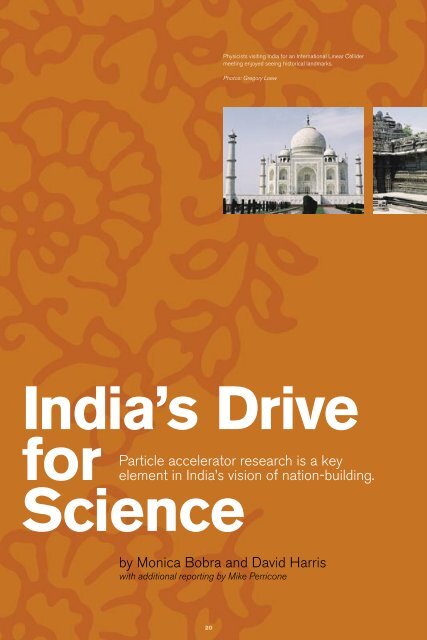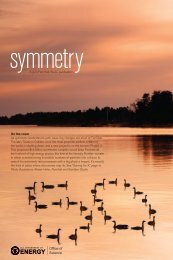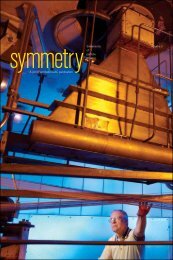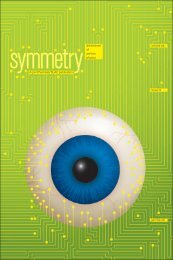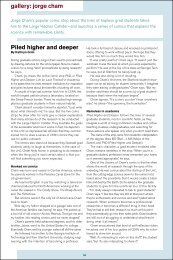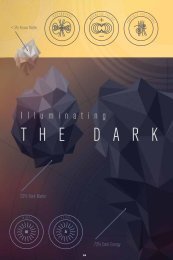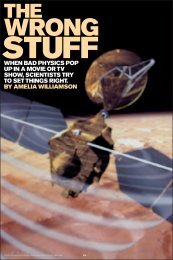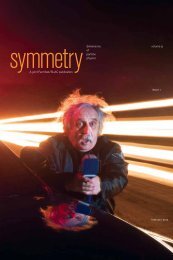Particle accelerator research is a key element in India's vision of ...
Particle accelerator research is a key element in India's vision of ...
Particle accelerator research is a key element in India's vision of ...
You also want an ePaper? Increase the reach of your titles
YUMPU automatically turns print PDFs into web optimized ePapers that Google loves.
Physic<strong>is</strong>ts v<strong>is</strong>it<strong>in</strong>g India for an International L<strong>in</strong>ear Collider<br />
meet<strong>in</strong>g enjoyed see<strong>in</strong>g h<strong>is</strong>torical landmarks.<br />
Photos: Gregory Loew<br />
India’s Drive<br />
for<br />
Science<br />
<strong>Particle</strong> <strong>accelerator</strong> <strong>research</strong> <strong>is</strong> a <strong>key</strong><br />
<strong>element</strong> <strong>in</strong> India’s v<strong>is</strong>ion <strong>of</strong> nation-build<strong>in</strong>g.<br />
by Monica Bobra and David Harr<strong>is</strong><br />
with additional report<strong>in</strong>g by Mike Perricone<br />
20
The Raja Ramanna Centre for Advanced Technology has<br />
recently comm<strong>is</strong>sioned its upgraded Indus-II X-ray<br />
light source.<br />
Photos: Monica Bobra<br />
The lush 1740-acre grounds with an artificial<br />
lake, tropical foliage, sport<strong>in</strong>g facilities, and small<br />
hospital do not immediately br<strong>in</strong>g to m<strong>in</strong>d a<br />
physics laboratory. But th<strong>is</strong> community <strong>in</strong> Indore,<br />
India, <strong>is</strong> home to 1200 people from across India,<br />
most <strong>of</strong> whom live and work on site <strong>in</strong> the<br />
recently rededicated Raja Ramanna Centre for<br />
Advanced Technology (RRCAT). Apart from the<br />
pleasant scenery and the fact that the lab<br />
functions <strong>in</strong> H<strong>in</strong>di and Engl<strong>is</strong>h, two <strong>of</strong> the sixteen<br />
languages recognized by the Indian government,<br />
RRCAT appears to be a smaller-scale version<br />
<strong>of</strong> a US particle physics lab.<br />
The Indian Department <strong>of</strong> Atomic Energy<br />
founded the lab, then called the Centre for<br />
Advanced Technology, as India’s entry <strong>in</strong> laser<br />
and <strong>accelerator</strong> physics <strong>in</strong> 1979. Now, the lab’s<br />
facilities are <strong>in</strong>ternationally competitive, <strong>in</strong>clud<strong>in</strong>g<br />
a newly upgraded synchrotron light source called<br />
Indus-II, and its products are benefit<strong>in</strong>g India’s<br />
society. And what could pass as a quiet, small<br />
town <strong>is</strong> a critical <strong>element</strong> <strong>in</strong> a science-and-technology<br />
revolution that <strong>is</strong> transform<strong>in</strong>g th<strong>is</strong> massive<br />
country, home to more than a billion people.<br />
Leaders revere science<br />
The president <strong>of</strong> India, Dr. A.P.J Abdul Kalam, has<br />
been a driv<strong>in</strong>g force beh<strong>in</strong>d the country’s recent<br />
emphas<strong>is</strong> on science. An aeronautical eng<strong>in</strong>eer<br />
by tra<strong>in</strong><strong>in</strong>g, he had a lengthy, d<strong>is</strong>t<strong>in</strong>gu<strong>is</strong>hed<br />
career as scient<strong>is</strong>t and science policy adv<strong>is</strong>or<br />
before becom<strong>in</strong>g a politician.<br />
Speak<strong>in</strong>g on May 11, 2006, India’s Technology<br />
Day, Kalam said, “Th<strong>is</strong> day rem<strong>in</strong>ds us: our<br />
constant strive to achieve self reliance <strong>in</strong> critical<br />
technologies, to encourage <strong>in</strong>novations and to<br />
nurture technology flow to <strong>in</strong>dustry for product<br />
excellence, so that our nation has the competitive<br />
edge lead<strong>in</strong>g to our cher<strong>is</strong>hed v<strong>is</strong>ion <strong>of</strong><br />
developed India.”<br />
The appreciation for science and technology<br />
as a driver <strong>of</strong> national development <strong>is</strong> rooted<br />
<strong>in</strong> the early years follow<strong>in</strong>g India’s <strong>in</strong>dependence<br />
<strong>in</strong> 1947. V<strong>is</strong>it<strong>in</strong>g the RRCAT lab and the Indus-II<br />
synchrotron, Prime M<strong>in</strong><strong>is</strong>ter Manmohan S<strong>in</strong>gh<br />
recently recalled the guid<strong>in</strong>g words <strong>of</strong> India’s<br />
first Prime M<strong>in</strong><strong>is</strong>ter, Jawaharlal Nehru: “Scientific<br />
<strong>in</strong>stitutions are the temples <strong>of</strong> modern India,<br />
and play a <strong>key</strong> role <strong>in</strong> the gigantic task <strong>of</strong> national<br />
development and nation build<strong>in</strong>g.”<br />
The director <strong>of</strong> RRCAT, V<strong>in</strong>od Sahni, says<br />
success generates credibility. “Start<strong>in</strong>g from<br />
scratch to accompl<strong>is</strong>h<strong>in</strong>g what we managed to<br />
accompl<strong>is</strong>h gives us a certa<strong>in</strong> respect,” he<br />
expla<strong>in</strong>s. “When you start from scratch, policymakers<br />
have some hesitation. They’re concerned<br />
about undertak<strong>in</strong>g a big project with a weak<br />
<strong>in</strong>frastructure. The gradient at which we have<br />
been able to grow, despite our constra<strong>in</strong>ts,<br />
means we must have an <strong>in</strong>nate capability.”<br />
Collaboration <strong>is</strong>sues<br />
RRCAT has fueled much <strong>of</strong> India’s current particle<br />
physics revolution, along with India’s collaborations<br />
at Fermilab <strong>in</strong> the United States and CERN<br />
<strong>in</strong> Europe. The Center for Advanced Technology<br />
led the LHC collaboration effort by build<strong>in</strong>g<br />
magnets. CAT outbid others for a US$25 million<br />
collaboration with CERN—and delivered the<br />
magnets ahead <strong>of</strong> schedule. The high quality <strong>of</strong><br />
the magnets led to Indian <strong>in</strong>dustry tak<strong>in</strong>g over<br />
some contracts that had <strong>in</strong>itially been awarded<br />
to others. The grow<strong>in</strong>g likelihood <strong>of</strong> <strong>in</strong>creased<br />
<strong>in</strong>volvement with R&D for the proposed<br />
International L<strong>in</strong>ear Collider (ILC) will fuel the<br />
revolution even further.<br />
Collaborat<strong>in</strong>g will help quicken the pace <strong>of</strong><br />
India’s scientific development, but there rema<strong>in</strong><br />
challenges <strong>in</strong> form<strong>in</strong>g effective collaborations.<br />
V<strong>in</strong>od Bharadwaj, <strong>of</strong> Stanford L<strong>in</strong>ear Accelerator<br />
symmetry | volume 03 | <strong>is</strong>sue 04 | may 06<br />
21
Photos: Gregory Loew<br />
Center (SLAC), po<strong>in</strong>ts to some <strong>of</strong> the <strong>is</strong>sues. “It <strong>is</strong> very<br />
difficult to get [collaboration] mov<strong>in</strong>g,” Bharadwaj<br />
says. “Part <strong>of</strong> it <strong>is</strong> to do with money—the dollar-to-rupee<br />
parity problem makes it expensive to buy <strong>in</strong>. Indians<br />
don’t have money to send people to the US to work if<br />
all the money has to come from India. And even if<br />
they do have the money, <strong>is</strong> it worth it, when that large<br />
amount could do so much more at home?”<br />
But, to India’s advantage, low labor costs and<br />
a rapidly-<strong>in</strong>creas<strong>in</strong>g population <strong>of</strong> scient<strong>is</strong>ts allowed<br />
RRCAT to be competitive <strong>in</strong> <strong>in</strong>ternational project<br />
bidd<strong>in</strong>g. Dur<strong>in</strong>g h<strong>is</strong> March 2006 v<strong>is</strong>it, Fermilab<br />
Director Pier Oddone observed that the Indus-II<br />
facility <strong>is</strong> beautifully laid out and very spacious.<br />
“The cost <strong>of</strong> build<strong>in</strong>g such a facility <strong>in</strong> the US would<br />
be a factor <strong>of</strong> five to ten greater if the cost were<br />
expressed <strong>in</strong> dollars,” Oddone says. “The Indian policy<br />
to be self-reliant and to build high-technology<br />
components <strong>in</strong>digenously has created capabilities<br />
for India to collaborate <strong>in</strong> <strong>in</strong>ternational projects.”<br />
The benefits <strong>of</strong> <strong>accelerator</strong>s<br />
The head <strong>of</strong> the Indian Department <strong>of</strong> Atomic<br />
Energy, Anil Kakodkar, has held annual meet<strong>in</strong>gs<br />
on the ILC and particle physics <strong>in</strong> recent years.<br />
These culm<strong>in</strong>ated <strong>in</strong> the March 2006 meet<strong>in</strong>g <strong>of</strong><br />
the ILC Global Design Effort (GDE) <strong>in</strong> Bangalore,<br />
a meet<strong>in</strong>g that could turn <strong>in</strong>to a milestone for particle<br />
physics <strong>in</strong> India, particularly for participation<br />
<strong>in</strong> the ILC. Indeed, Indian <strong>in</strong>stitutions are on the<br />
verge <strong>of</strong> sign<strong>in</strong>g Memoranda <strong>of</strong> Understand<strong>in</strong>g with<br />
US <strong>in</strong>stitutions, and RRCAT scient<strong>is</strong>ts are already<br />
collaborat<strong>in</strong>g with CERN physic<strong>is</strong>ts on grid-comput<strong>in</strong>g<br />
systems for the ILC.<br />
Dur<strong>in</strong>g their trip to India, the directors <strong>of</strong> Fermilab,<br />
SLAC, and DESY–Oddone, Jonathan Dorfan, and<br />
Albrecht Wagner, respectively–along with GDE<br />
director Barry Bar<strong>is</strong>h, met with President Kalam.<br />
Oddone says, “He [Kalam] was <strong>in</strong>terested <strong>in</strong><br />
and supportive <strong>of</strong> the basic science goals <strong>of</strong> the<br />
ILC, but he also wanted to know the possible<br />
practical applications for India that would ensue<br />
from the ILC <strong>accelerator</strong> R&D.”<br />
One <strong>of</strong> the potential applications ar<strong>is</strong><strong>in</strong>g from<br />
ILC <strong>in</strong>volvement could help India develop<br />
energy <strong>in</strong>dependence. Accelerator technology <strong>is</strong><br />
needed to take advantage <strong>of</strong> India’s abundant<br />
supplies <strong>of</strong> natural thorium, which are 30% <strong>of</strong><br />
the world’s supply. Nuclear power can be generated<br />
us<strong>in</strong>g thorium <strong>in</strong>stead <strong>of</strong> uranium, leav<strong>in</strong>g<br />
shorter-lived radioactive byproducts which<br />
are unsuitable for weaponization. The process<br />
can also burn up conventional, long-lived nuclear<br />
waste. However, start<strong>in</strong>g the thorium fuel cycle<br />
requires a source <strong>of</strong> neutrons, someth<strong>in</strong>g that<br />
could only be efficiently provided with a particle<strong>accelerator</strong>-based<br />
neutron source. Although<br />
the ILC itself would not provide the neutrons,<br />
work<strong>in</strong>g on the technology would give Indian<br />
physic<strong>is</strong>t the <strong>accelerator</strong> skills they need to<br />
develop a neutron source.<br />
The quest for <strong>accelerator</strong> technologies <strong>is</strong><br />
already help<strong>in</strong>g Indian society <strong>in</strong> real ways. Like<br />
many Indian scient<strong>is</strong>ts, S.C. Bapna at RRCAT<br />
focuses on work to benefit the country’s huge<br />
and largely poor population. Some twenty percent<br />
<strong>of</strong> India’s food per<strong>is</strong>hes because <strong>of</strong> limited<br />
shelf life. Bapna uses the 10-millimeter beam <strong>of</strong><br />
a 10 MeV l<strong>in</strong>ear <strong>accelerator</strong> to irradiate a potato,<br />
delay<strong>in</strong>g the appearance <strong>of</strong> sprouts that <strong>in</strong>duce<br />
spoilage. “For the first time <strong>in</strong> the world, we’ve<br />
shown that surface irradiation <strong>is</strong> good enough<br />
to prevent sprout<strong>in</strong>g,” he says. Bapna <strong>is</strong> generaliz<strong>in</strong>g<br />
h<strong>is</strong> method to apply to many other crops.<br />
“I’m very much sat<strong>is</strong>fied that what I am do<strong>in</strong>g <strong>is</strong><br />
directly useful to mank<strong>in</strong>d,” says Bapna.<br />
Indus-II’s <strong>in</strong>digenous orig<strong>in</strong>s<br />
The Indus-II synchrotron light source <strong>is</strong> the most<br />
recent large <strong>accelerator</strong> project to be completed<br />
22
Photo: Monica Bobra<br />
<strong>in</strong> India, but reflects the Indian homegrown and<br />
practical approach to <strong>accelerator</strong> science.<br />
Twenty-six beaml<strong>in</strong>es branch out from Indus-<br />
II’s circular pipel<strong>in</strong>e like spokes out <strong>of</strong> a bicycle<br />
wheel’s hub, each beaml<strong>in</strong>e funnel<strong>in</strong>g X-rays<br />
down to a m<strong>in</strong>uscule target. And that’s where<br />
the magic happens, <strong>in</strong> areas <strong>of</strong> <strong>research</strong> rang<strong>in</strong>g<br />
from material sciences and chem<strong>is</strong>try to atomic<br />
physics and biology.<br />
For example, it has long been a difficult problem<br />
to rid petroleum <strong>of</strong> air-pollut<strong>in</strong>g sulfur. Plac<strong>in</strong>g<br />
a sample <strong>of</strong> petroleum <strong>in</strong> high-energy X-rays from<br />
an Indus-II beaml<strong>in</strong>e would literally shed <strong>in</strong>tense<br />
light on a petroleum sample’s structure—and<br />
allow scient<strong>is</strong>ts to determ<strong>in</strong>e exactly how sulfur<br />
molecules hide with<strong>in</strong> clusters <strong>of</strong> hydrocarbons.<br />
“You can detect the <strong>element</strong>al composition <strong>of</strong><br />
materials and impurity levels <strong>in</strong> parts per billion or<br />
even better,” says RRCAT experimental<strong>is</strong>t R.V.<br />
Nandedkar, one <strong>of</strong> 400 scient<strong>is</strong>ts and eng<strong>in</strong>eers<br />
<strong>in</strong>volved <strong>in</strong> design<strong>in</strong>g Indus-II.<br />
Most <strong>of</strong> the Indus-II synchrotron light source<br />
was built <strong>in</strong> India. Only the superconduct<strong>in</strong>g<br />
radio-frequency cavities, which accelerate the<br />
electrons, and the klystrons, which provide the<br />
cavities with microwave energy, were manufactured<br />
abroad. The “made at home” approach<br />
reflects a cultural value <strong>of</strong> a Ghandi-<strong>in</strong>spired<br />
“<strong>in</strong>digenousness” to spread knowledge, respect<br />
and experience throughout the community.<br />
Use <strong>of</strong> synchrotron light sources <strong>is</strong> a growth<br />
<strong>in</strong>dustry around the world, and Indus-II <strong>is</strong> set to<br />
help India develop its domestic <strong>research</strong> base.<br />
In a May 2005 address to the Indian Council<br />
for Scientific and Industrial Research, Prime<br />
M<strong>in</strong><strong>is</strong>ter S<strong>in</strong>gh emphasized an <strong>in</strong>digenousness <strong>of</strong><br />
knowledge as the path to the future. “People<br />
say that twenty-first century will be the century<br />
<strong>of</strong> knowledge,” S<strong>in</strong>gh said. “If th<strong>is</strong> <strong>is</strong> so, then<br />
our foundations on production, d<strong>is</strong>tribution, protection,<br />
and utilization <strong>of</strong> knowledge must be<br />
strong. Dom<strong>in</strong>ance <strong>of</strong> knowledge economy over<br />
the old ‘brick-and-mortar’ economy <strong>is</strong> v<strong>is</strong>ible<br />
around the world. I am conv<strong>in</strong>ced that th<strong>is</strong> <strong>is</strong><br />
where the Indian advantage lies.”<br />
symmetry | volume 03 | <strong>is</strong>sue 04 | may 06<br />
2 3<br />
Delegation v<strong>is</strong>it<strong>in</strong>g the President <strong>of</strong> India before the Bangalore ILC workshop,<br />
from left to right: Albrecht Wagner, DESY; Jonathan Dorfan, SLAC; Shekhar M<strong>is</strong>hra,<br />
Fermilab; President <strong>of</strong> India Abdul Kalam; Barry Bar<strong>is</strong>h, ILC GDE Director;<br />
Pier Oddone, Fermilab; Bob Kephart, Fermilab and Ram Shivpuri, University <strong>of</strong> Delhi.<br />
Photo courtesy <strong>of</strong> Pier Oddone


